The AMD Ryzen Threadripper 3960X and 3970X Review: 24 and 32 Cores on 7nm
by Dr. Ian Cutress, Andrei Frumusanu & Gavin Bonshor on November 25, 2019 9:05 AM ESTGaming: Grand Theft Auto V
The highly anticipated iteration of the Grand Theft Auto franchise hit the shelves on April 14th 2015, with both AMD and NVIDIA in tow to help optimize the title. GTA doesn’t provide graphical presets, but opens up the options to users and extends the boundaries by pushing even the hardest systems to the limit using Rockstar’s Advanced Game Engine under DirectX 11. Whether the user is flying high in the mountains with long draw distances or dealing with assorted trash in the city, when cranked up to maximum it creates stunning visuals but hard work for both the CPU and the GPU.
For our test we have scripted a version of the in-game benchmark. The in-game benchmark consists of five scenarios: four short panning shots with varying lighting and weather effects, and a fifth action sequence that lasts around 90 seconds. We use only the final part of the benchmark, which combines a flight scene in a jet followed by an inner city drive-by through several intersections followed by ramming a tanker that explodes, causing other cars to explode as well. This is a mix of distance rendering followed by a detailed near-rendering action sequence, and the title thankfully spits out frame time data.
There are no presets for the graphics options on GTA, allowing the user to adjust options such as population density and distance scaling on sliders, but others such as texture/shadow/shader/water quality from Low to Very High. Other options include MSAA, soft shadows, post effects, shadow resolution and extended draw distance options. There is a handy option at the top which shows how much video memory the options are expected to consume, with obvious repercussions if a user requests more video memory than is present on the card (although there’s no obvious indication if you have a low end GPU with lots of GPU memory, like an R7 240 4GB).
All of our benchmark results can also be found in our benchmark engine, Bench.
| AnandTech | IGP | Low | Medium | High |
| Average FPS | 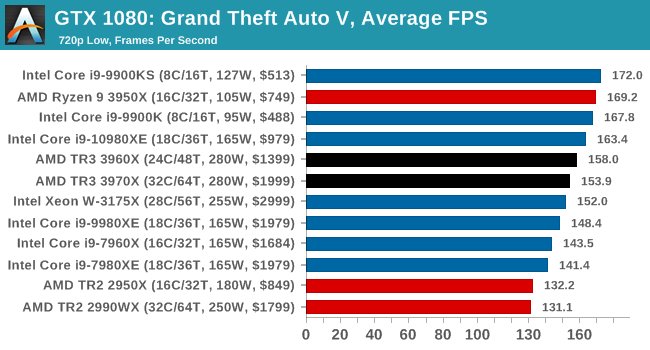 |
 |
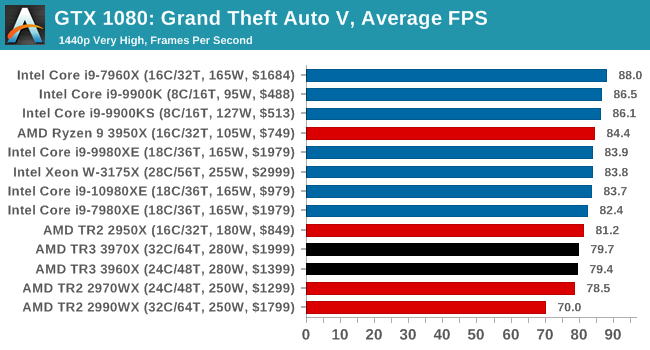 |
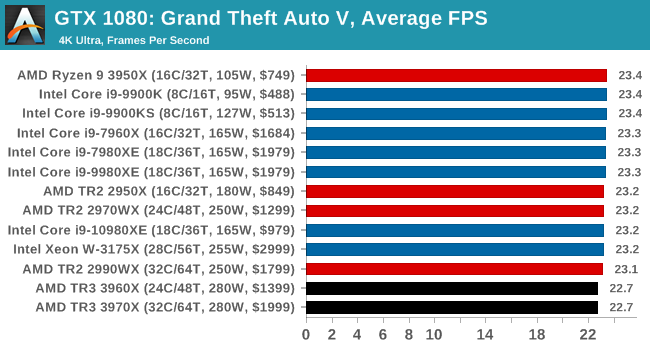 |
| 95th Percentile |  |
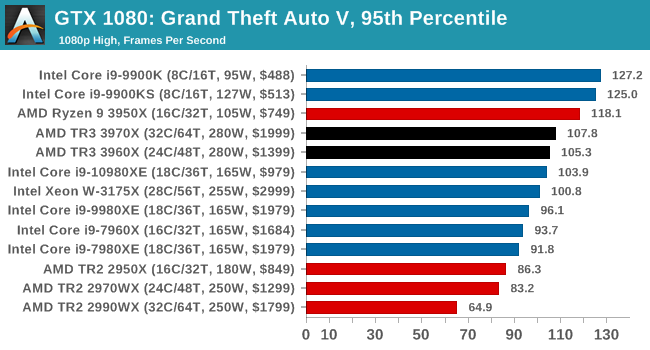 |
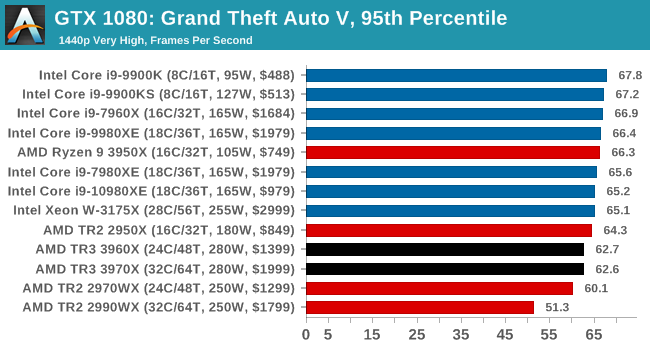 |
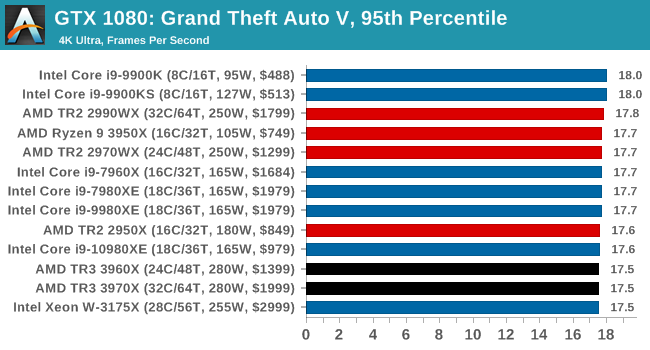 |


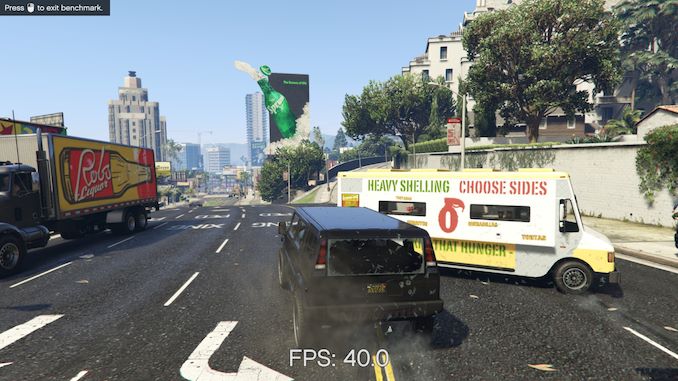









245 Comments
View All Comments
PeachNCream - Tuesday, November 26, 2019 - link
Very much agree with this statement. Desktops are a shrinking market segment. Mainstream home users and corporate office computing assets are generally now laptops regardless of whether or not the mobility makes sense or is a necessity. Yes, there is a market for desktop computers and that market does include massively parallel workloads that benefit from lots of cores/threads, but the center of mass in terms of money in CPU sales has shifted to portable computing where AMD is still lagging due mainly to power consumption and heat output. The I/O die design AMD uses is not so great in that sense and Intel still has an advantage in the mobiel sector.Xyler94 - Tuesday, November 26, 2019 - link
Both of you are actually wrong.Intel doesn't care about laptops, it's a side project basically. Both Intel and AMD want Server space. Servers are the heart of the market. Especially Supercomputers. Intel wouldn't care one bit if AMD took 25% of the laptop market, but you can see Intel scrambling and panicking at every single percent AMD gains in the Server Market.
Laptop CPUs are so little margin, Intel wouldn't actually care if people buy AMD. Servers and HEDT processors are such high margin, they'd rather 1 person buy a Xeon or 2066 processor than 10 people buying laptops. It's all about profits, not units sold.
PeachNCream - Tuesday, November 26, 2019 - link
Have you looked at Intel and/or AMD's income breakdowns out of their financial reports? I have. You're assertion is not correct.Korguz - Tuesday, November 26, 2019 - link
" Desktops are a shrinking market segment " im not so sure about that... no one i know wants a notebook, for portability, they have their phones or tablets for that...upanddown - Monday, November 25, 2019 - link
Your revenue numbers don't mean anything. 15 years ago Nokia was also unbeatable, as well as Yahoo, MySpace etc..For Intel, there is a chance that similar to "after-Athlon" era will never come again.
Xyler94 - Monday, November 25, 2019 - link
Especially since the bribes are what made Intel keep goingdrothgery - Monday, November 25, 2019 - link
No, what made Intel keep on going was AMD's lack of manufacturing capacity (they couldn't have supplied much more than 25% of the CPU market in the Athlon 64 X2 era even if they wanted to), inferior laptop CPUs, and lack of infrastructure to support their server/workstation CPUs. Since going fabless, they're nowhere near as capacity constrained now, and may have more of the server infrastructure figured out... but Zen 3 doesn't have anywhere near the advantage on 10th-gen Core that Athlon 64 X2 derivatives had on Pentium 4 derivatives, either.If Intel can get cores/$ and total core counts reasonably close to EPYC and TR (which is likely), they'll be fine in the long run.
Korguz - Monday, November 25, 2019 - link
drothgery you didnt hear about how intel would bribe and threaten OEMs and the like NOT to use amd products ? thats what hurt amd way back when, thats why intel payed a billion or so to amd to settle that.. what advantage ?? zen 2 has more IPC then intel, why do you think intel needs such high clock speeds to compete with lower clocked cpus ??Xyler94 - Tuesday, November 26, 2019 - link
You don't know the history of the mid 2000s, do you?drothgery - Tuesday, November 26, 2019 - link
Reality and AMD fanboy mythology are not the same.Did Intel do some shady things in the P4 era? Yes. But that wasn't the biggest reason why AMD failed to gain more ground than they did on Intel then.
Did AMD have the manufacturing capacity to handle a significantly bigger market share than they actually got? No.
Did Opeteron have serious infrastructure issues vs Xeon? Yes, they did.
Did AMD's laptop chips suck compared to Pentium M and its follow-ons? Also yes.